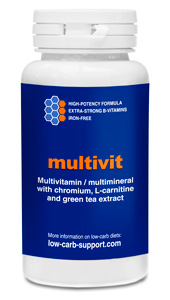 Atkins Induction means goodbye to carb-rich side dishes such as rice or potatoes.
Atkins Induction means goodbye to carb-rich side dishes such as rice or potatoes.
Instead, you can have vegetables – up to 20g of net carbs a day.
As vegetables are the main source of permitted carbs, you might actually eat more of them on Atkins than before.
If you are one of these people who never used to eat anything green, here are some tips on cooking Atkins Induction vegetables.
The list of permitted vegetables and corresponding carb counts are from Phase 1 page on Atkins website.
1) Best for salads
Salad is not difficult to make! Just chop up any vegetables listed below in any combination.
Salads are the best way to retain all vitamins and nutrients in vegetables. Cooking destroys some of them, so opt for fresh vegetables whenever you can.
Dressing is the key to making any salad taste nice – for the simplest dressing, combine 1 part oil (preferably olive) with 1 part wine vinegar.
Make your own salad dressings while on Induction, as shop-bought versions might be laden with carbs.
New Atkins for New You book has a huge section on dressings and sauces recipes.
Salad cooking time: 5 minutes
| Vegetable | Serving size | Net carbs (g) |
|---|---|---|
| Avocados | ½ whole (raw) | 1.8 |
| Chives | 1 tablespoon | 0.1 |
| Cucumber | ½ cup | 1 |
| Daikon | ½ cup | 1 |
| Iceberg lettuce | 1 cup | 0.2 |
| Parsley | 1 tablespoon | 0.1 |
| Radicchio | ½ cup/raw | 0.7 |
| Radishes | 6/raw | 0.5 |
| Rocket salad (US name: Arugula) | 1 cup/raw | 0.4 |
| Romaine lettuce | 1 cup | 0.4 |
| Tomato | ¼ cup | 4.3 |
2) Best for steaming
You can steam-cook vegetables by placing them on top of a pan of boiling water, in a colander or a steamer. The taste is similar to boiled vegetables, but veggies don’t get soggy or watery.
I recommend getting a steamer – you can definitely use it a lot while on Atkins.
Alternatively, just use a colander or a sieve to hold your vegetables on top of the boiling water.
Dress steamed veg with butter (20g / 0.6oz would usually be enough) and/or grated cheese (15g / 0.5 oz).
Steaming cooking time: 10-15 minutes
| Vegetable | Serving size | Net carbs (g) |
|---|---|---|
| Asparagus | 6 spears | 2.4 |
| Broccoli raw | ½ cup | 0.8 |
| Brussels sprouts | ¼ cup | 1.8 |
| Cauliflower | ½ cup (raw) | 1.4 |
| Green String Beans | 1 cup | 4.1 |
| Snow peas and snap peas in pod | ½ cup with pods | 3.4 |
| Spinach | ½ cup | 2.2 |
| Swiss chard | ½ cup | 1.8 |
3) Best for sautéing
Sautéing is a fancy name for pan-frying on high heat using a small amount of fat – either oil or butter.
Chop and fry gently in a pan with a some butter (10-15g, 0.3-0.5oz) or 1 tbsp of oil, on medium to high heat. Use a wide, shallow pan and turn the veg over several times.
Sautéing cooking time: 10-15 minutes
| Vegetable | Serving size | Net carbs (g) |
|---|---|---|
| Bamboo shoots | ½ cup | 1.2 |
| Cabbage | ½ cup (raw) | 1.6 |
| Chicory greens | ½ cup/raw | 0.1 |
| Courgettes (US name: zucchini) | ½ cup | 1.5 |
| Endive | ½ cup | 0.4 |
| Hearts of palm | 1 heart | 0.7 |
| Mushrooms | ½ cup | 1.2 |
| Okra | ½ cup | 2.4 |
| Onion | ¼ cup | 4.3 |
4) Best for stir-fry
Stir-fry is similar to sautéing, but done over very high heat, and with constant stirring of the veg to avoid burning them.
You can add thin strips of meat, poultry or seafood into the same pan, and cook together with the vegetables.
Don’t use butter for this method, as it will burn. Use a vegetable oil with a high smoking point, like coconut, peanut or canola.
Don’t use shop-bought stir-fry sauces, as they might contain carbs. Jazz up your stir-fry with oriental spices and seeds,
Cut your ingredients into very thing strips. Cook quickly in a wok or a large frying pan, turning constantly.
Stir-fry cooking time: 5-10 minutes
| Vegetable | Serving size | Net carbs (g) |
|---|---|---|
| Alfalfa sprouts | ½ cup/raw | 0.2 |
| Fennel | ½ cup | 1.8 |
| Leeks | ½ cup | 3.4 |
5) Best for boiling
Boiling is a simple method that works well for green vegetables. Just boil some water and chuck in the veg.
Take care not to overboil the veg, as it might become soggy and boring.
Boiling cooking time: 10-20 minutes
| Vegetable | Serving size | Net carbs (g) |
|---|---|---|
| Artichoke | 1/2 medium | 3.5 |
| Bok choy | 1 cup/raw | 0.4 |
| Collard greens | ½ cup boiled | 2.0 |
| Kale | ½ cup | 2.4 |
| Kohlrabi | ¼ cup | 2.3 |
6) Best for roasting
Roasting is the slowest method for cooking vegetables, but it produces very nice tasting results.
Slice the vegetables, brush with oil and season with salt and pepper. Roast for 20-40 minutes at 190C/375F/Gas Mark 5.
Roasting cooking time: 20-45 minutes
| Vegetable | Serving size | Net carbs (g) |
|---|---|---|
| Aubergine (US name: Eggplant) | ½ cup | 2 |
| Jicama (Mexican yam) | ½ cup | 2.5 |
| Peppers | ½ cup/raw | 2.3 |
| Pumpkin | ¼ cup | 2.4 |
| Rhubarb | ½ cup (unsweetened) | 1.7 |
| Spaghetti squash | ¼ cup boiled | 2 |
| Summer squash | ½ cup | 2.6 |
| Turnips | ½ cup | 3.3 |
7) Best for eating raw on its own
Some vegetables don’t need any cooking at all. Just munch them raw as they are.
| Vegetable | Serving size | Net carbs (g) |
|---|---|---|
| Celery | 1 stalk | 0.8 |
| Olives green | 5 | 0.1 |
| Olives black | 5 | 0.7 |
| Sauerkraut | ½ cup (drained) | 1.2 |
You might also like these posts
- 7 low-carb potato substitutes
- Courgettes: low-carb veg that works with everything
- Cauliflower on a low-carb diet
- How to make perfect cauliflower mash
Further reading on Atkins Induction foods
Dr Atkins New Diet Revolution
Updated edition (2003) of the original book, written by the man himself
Buy this book on Amazon UK | Buy this book on Amazon US
New Atkins for New You
Revised version of the diet (2010), written by Eric C Westman; Stephen D Phinney; Jeff S Volek
Buy this book on Amazon UK | But this book on Amazon US
Atkins Diet Official Website
UK site | US site | Other regions
 Are you currently on Atkins Induction?
Are you currently on Atkins Induction?
Check out Nutri-Align Multivit – multivitamin formula designed to make your low-carb diet easier. Perfect supplement to support Atkins Induction!
That’s true — Qwave Beach Gear definitely found myself eating way more greens once I started Atkins than I ever did before!
That’s true — I definitely found myself eating way more greens once I started Atkins than I ever did before!
I appreciated how clearly this post breaks down the importance of vegetables during the Atkins Induction phase—highlighting that up to about 20 grams of net carbs per day should come from foundation vegetables like leafy greens and other low-starch options . It’s a helpful reminder that, especially during restrictive phases, the quality of carbs matters just as much as the quantity. When you’re putting that much thought into what you include in your daily plan, having dependable support elsewhere—like a secure and accessible spot for storage—can be just as valuable. Great, practical tips here! 🙂
Wow. This is new to me! Very interesting. 🙂
Fresh vegetables are preferable whenever possible because cooking destroys some of them.
To preserve all the vitamins and nutrients in veggies, salads are the greatest option. Fresh vegetables are preferable whenever possible because cooking destroys some of them. Thanks!